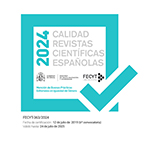Women in Ecuador: the required scapegoat
Resumen
Introducción. El concepto de chivo expiatorio, es un concepto amplio para adoptar ya que se asocia con algo desconocido o algo malvado que se debe erradicar por medio de la coerción, debido a que es una amenaza. Sin embargo, la idea principal del concepto de chivo expiatorio es que este produce un miedo existencial, el cual se extrapola como un a priori o una base, para la construcción de la identidad nacional. El chivo expiatorio es requerido para construir los círculos cálidos en el Estado-Nación, es decir que los conceptos de amenaza e identidad son mutuamente constitutivos más no excluyentes. En Ecuador, uno de los grupos que históricamente han sido coercionadas son las mujeres. Objetivo & Metodología. Por lo tanto, este artículo cualitativo argumentará que las mujeres cisgénero actualmente Ecuador las usa como el chivo expiatorio para la construcción de identidad nacional. Resultados. Durante la pandemia de COVID 19 las tendencias de coerción hacia las mujeres cisgénero incrementó pese a las políticas públicas que sancionan la violencia contra las mujeres nacionalmente. Discusión & Conclusiones. Por otro lado, el artículo explora como la sociedad ecuatoriana sanciona a las mujeres cisgénero, los chivos expiatorios, por medio de estándares/roles sociales que fomentan la construcción de la identidad. Ecuador tiene leyes de paridad vigentes que aún no se llegan a concretar como por ejemplo la representación igualitaria en la política nacional, la disminución de la violencia contra las mujeres, e el desempleo femenino durante y después de la pandemia. Todo esto se da debido a que el chivo expiatorio no solo es la causa de los problemas, sino que también son la solución del problema de la sociedad. Por ende, la necesidad de mantener una violencia sostenible a las mujeres, que se ve en las pocas leyes de protección hacia las mujeres.
Descargas
Descarga artículo
Licencia
La revista Investigaciones Feministas, para fomentar el intercambio global del conocimiento, facilita el acceso sin restricciones a sus contenidos desde el momento de su publicación en la presente edición electrónica, y por eso es una revista de acceso abierto. Los originales publicados en esta revista son propiedad de la Universidad Complutense de Madrid y es obligatorio citar su procedencia en cualquier reproducción total o parcial. Todos los contenidos se distribuyen bajo una licencia de uso y distribución Creative Commons Reconocimiento 4.0 (CC BY 4.0). Esta circunstancia ha de hacerse constar expresamente de esta forma cuando sea necesario. Puede consultar la versión informativa y el texto legal de la licencia.











